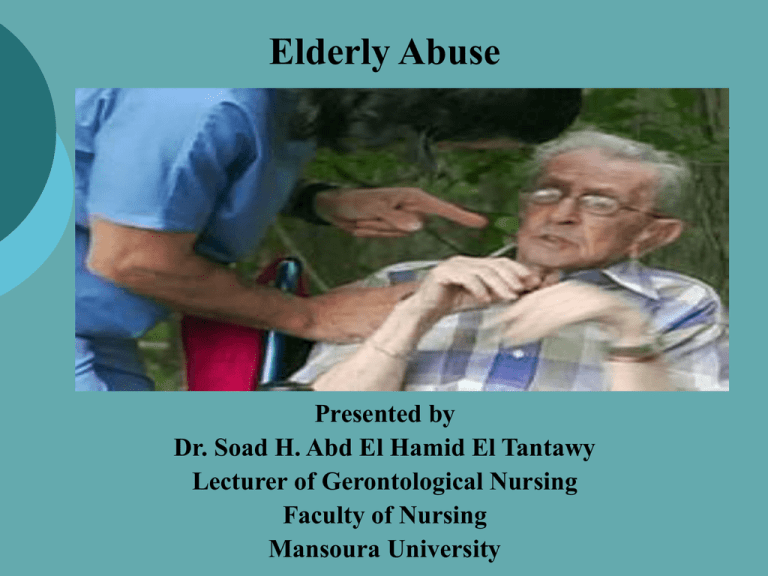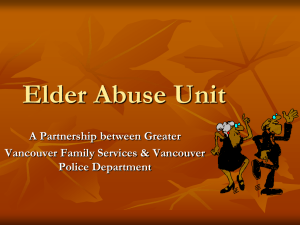
Elderly Abuse
Presented by
Dr. Soad H. Abd El Hamid El Tantawy
Lecturer of Gerontological Nursing
Faculty of Nursing
Mansoura University
Elderly Abuse
Outline:
Introduction
Definition of elder abuse
Incidence of elder abuse
Types of elder abuse
Risk factors for elder abuse
Preventing of elder abuse
Health education to prevent elder abuse
Introduction
Abuse and neglect of the elderly tends
to regarded as relatively recent phenomena.
Elder abuse is alarming social problem,
it is a difficult, complex and sensitive
area. It involve interpersonal relationships
and difficulties in relationships which may
have lasted for years
Definition of elderly abuse
Elderly abuse was defined as an act or
omission which results in harm or
threatened harm to the health or welfare of
an elderly person.
Incidence of elderly abuse
Abuse in institutional settings is difficult to
measure, yet is thought to exceed that in
community settings.
In the USA,10% of nursing staff in
institutional settings admitted committing
physical and 40% psychological abuse against
residents .
Types of elder abuse
Physical abuse
Sexual abuse
Neglect ( intentional or unintentional)
Emotional or Psychological abuse
Material abuse
Financial exploitation.
Domestic abuse
Self-neglect
Physical abuse
Physical abuse means at
least one act of physical
violence against the elderly
Forms of physical abuse
Direct beatings
Hitting
Slapping
Cutting
Burning
shaking
Physical coercion
Unreasonable physical
restraints
Maltreatment of medical
conditions
Sexual assault
Prolonged deprivation of
food or water.
Sings of physical abuse
Include bruises
Broken bones, sprains, or dislocations
Report of drug overdose or apparent failure to
take medication regularly
Broken eyeglasses or frames
Signs of being restrained, such as rope marks on
wrists
Caregiver’s refusal to allow you to see the elder
alone
Sexual abuse
Sexual abuse is unwanted sexual contact
with an elder including touching, sexual assault,
and rape.
Signs of sexual abuse
Signs Bruises around breasts or genitals
Unexplained venereal disease or genital infections
Unexplained vaginal or anal bleeding
Torn, stained, or bloody underclothing
Neglect
The failure of a designated caregiver
to meet the needs of an elderly person, and
withholding of physical, material, or
emotional necessities of physical and
mental health, whether intentionally or
unintentionally.
This includes failure to assist in
personal hygiene or the provision of
clothing for an elder, failure to provide
medical care for the physical and mental
health needs of an elder, and failure to
protect an elder from health and safety
hazards.
Signs of neglect
Malnutrition, dehydration
Lack of personal care
Inadequate heating
Unclean clothes or bedding
Lack of needed medications, eye glasses, hearing aids,
or dentures
Contractures, decubitus ulcers, wasting and muscle
atrophy
Psychological abuse or emotional abuse
Psychological abuse is more difficult
to define and operationalize.
Usually defined as an act carried out
with the intention of causing
emotional pain or distress.
Psychological abuse often
accompanies physical abuse.
Emotional abusers can use verbal and
non verbal to inflict elder damage.
Verbal forms of emotional elder abuse
Intimidation through yelling or threats
Name –calling
Harsh orders
Humiliation and ridicule
Habitual blaming or scapegoat
Nonverbal psychological elder abuse can take the form
of: Ignoring the elderly person
Isolating an elder from friends or activities
Terrorizing or menacing the elderly person
Forbid visitors and isolate form sympathetic friend
Signs of psychological abuse
Anxiety (mild to severe) .
Depression, hopelessness, helplessness,
thoughts of suicide
Confusion, disorientation
Trembling, lack of eye contact
Agitation
Financial or material abuse
Any theft or misuse of an elderly money or
property by a person in a position of trust with
an elder constitutes financial abuse.
Material abuse involves the misappropriation
or misuse of funds or possessions.
Forms of financial abuse : Misuse an elder’s personal checks, credit
cards, or accounts
Steal cash, income checks, or household goods
Forge the elder’s signature
Domestic abuse
Refer to forms of maltreatment
by someone who has a special
relationship with the elder such
as family member or caregiver .
Institutional elder abuse
Refers to abuse that occur in residential
institutions such as nursing facilities usually by
someone who is paid caregiver, such as nursing
facility staff member.
Residents at the greatest risk for institutional
abuse or neglect includes resident with
dementia, resident who seldom have visitors.
Risk factors for elderly abuse
I. factor related to the abused elderly:
The intensity of an elderly person’s illness or dementia
Social isolation
The elder’s role, at an earlier time, as an abusive parent
or spouse
A history of domestic violence in the home
Dependency
II. factors related to the abuser:
Inability to cope with stress (lack of resilience)
Depression, which is common among caregivers
Lack of support from other potential caregivers
The caregiver’s perception that taking care of
the elder is burdensome and without
psychological reward
Substance abuse
Preventing elder abuse and neglect
Preventing elder abuse means doing three
things:
Listening to elderly and their caregivers
Intervening when you suspect elder abuse
Educating others about how to recognize and report
elder abuse
Reporting elder abuse
If you are an elder who is
being abused, neglected, or
exploited, tell at least one
person. Tell your doctor, a
friend, or a family member
whom you trust.
Health education to prevent elder
abuse
Instructions to a caregiver:If the caregiver overwhelmed by the
demands of caring for an elder, instruct
(he /she ) to do the following:
Request help, from friends, relatives, or local
respite care agencies, so you can take a break, if
only for a couple of hours.
Find an adult day care program.
Stay healthy and get medical care for yourself
when necessary.
Adopt stress reduction practices.
Seek counseling for depression, which can lead to
elder abuse.
Find a support group for caregivers of the elderly.
If caregiver is having a problems with drug or
alcohol abuse, get help.
Instructions to a concerned friend or
family member
Watch for warning signs that might indicate elder abuse. If you
suspect abuse, report it.
Take a look at the elder’s medications. Does the amount in the
vial matched with the date of the prescription?
Watch for possible financial abuse. Ask the elder if he may scan
bank accounts and credit card statements for unauthorized
transactions.
Call and visit as often as you can. Help the elder consider you a
trusted confidante.
Offer to stay with the elder so the caregiver can have a break —
on a regular basis, if you can.
Instructions to the elderly
Make sure your financial and legal affairs are in order. If they
aren’t, enlist professional help to get them in order, with the
assistance of a trusted friend or relative if necessary.
Keep in touch with family and friends and avoid becoming
isolated, which increases your vulnerability to elder abuse.
If you are unhappy with the care you’re receiving, whether it’s
in your own home or in a care facility, speak up. Tell someone
you trust and ask that person to report the abuse or neglect.
Thank you








